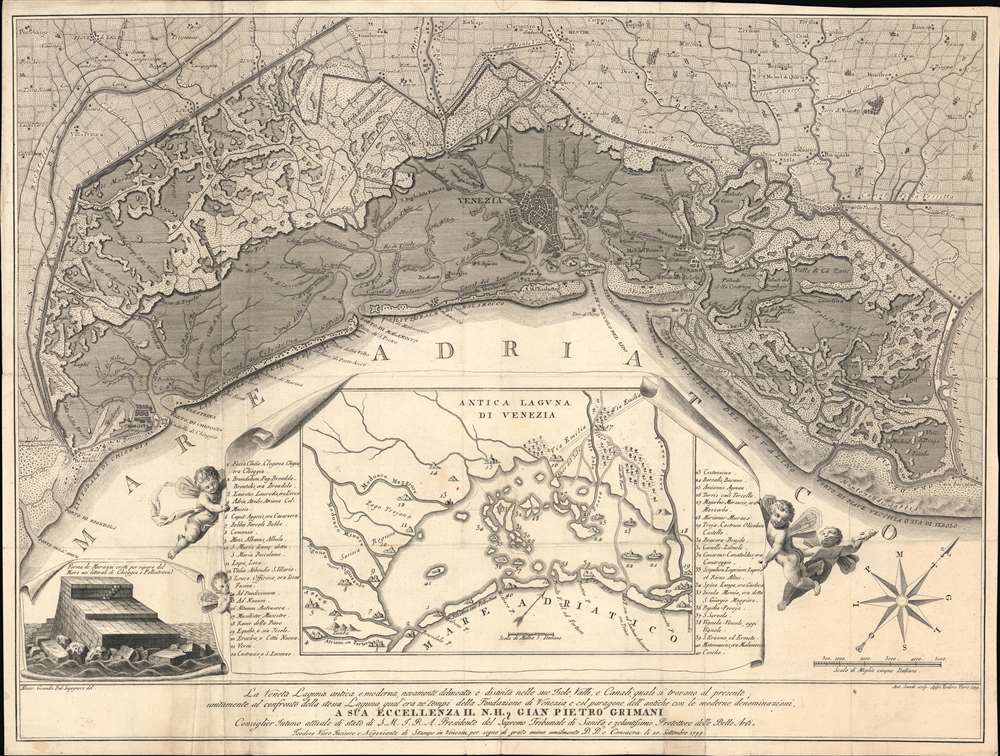1799 Viero / Sandi Map of Venice and its Lagoon
Venice-viero-1799
Title
1799 (dated) 19 x 25 in (48.26 x 63.5 cm) 1 : 80000
Description
A Closer Look
This map offers an overhead view of Venice and its hinterland, indicating the changes in the terrain over time and the environmental modifications that made the city's growth and continued existence possible. At the top is a contemporary map of Venice, the lagoon, and its hinterland, highlighting differences in elevation, land use, aqueducts, canals, and other features of the terrain and infrastructure that developed over centuries to manage the waters of the lagoon.The large inset at bottom illustrates the lagoon in ancient times, indicating important sites, including the Roman-era Via Emilia. At the bottom left is an illustration of the muezzin, a series of large stone breakwaters built to protect Venice against the sea - an engineering marvel completed at enormous expense in the years leading up to the collapse of the Venetian Republic.
Rescuing Venetian Identity
This map was produced at a fraught moment in Venice's history. After having existed as a republic for over a millennium, the city was occupied by Napoleon's army and then placed under Austrian rule as part of a peace deal at the end of the War of the First Coalition (1792 - 1797). The emphasis on the history of the city and lagoon can be seen as a subtle act of resistance against this new political reality. The dedication of the map to Pietro Grimani, a popular and learned Doge of Venice in the mid-18th century, was also likely an attempt to reinforce civic pride.Austrian control of Venice was never solidly secured. The city was reconquered by Napoleon in 1805 before being returned to Austria as the Kingdom of Lombardy-Venitia at the end of the Napoleonic Wars. Though the Austrian Empire was cosmopolitan and staffed the local bureaucracy with Italians, the arrangement was never popular and became less so as Italian nationalism grew throughout the 19th century. Resistance came to the fore during the Revolutions of 1848 when a republican government was briefly (re)established. Though that movement was crushed, the city was at the center of the Third Italian War of Independence (1866), after which it joined the Kingdom of Italy.
Publication History and Census
This map was drawn by Alvise Grandis, engraved by Antonio Sandi, and published by Teodoro Viero in Venice in September 1799. It is worth noting that in the same year, Sandi and Francesco Tironi also published a set of 24 views of the Venetian Lagoon. The present map is listed in more than 30 OCLC entries due to inconsistent cataloging, the existence of a later (1820) edition, and digital scans of both editions. Allowing that most Italian libraries are not integrated with the OCLC, we can confirm that a physical copy of this map is held in about a dozen institutions in North America and Europe.CartographerS
Teodoro Viero (1740 - 1819) was an engraver and publisher based in Venice who specialized in views of the city. He trained under Nicolo Cavalli and was the uncle of Luigi Schiavonetti. More by this mapmaker...
Antonio Sandi (October 9, 1733 - September 4, 1817) was an Italian engraver based in Venice who specialized in the production of large scale vedute. His brother Giuseppe (1763 -1803) was also an engraver. He collaborated with Francesco Tironi and Teodoro Viero among others in producing views of Venice and its lagoon. Learn More...

